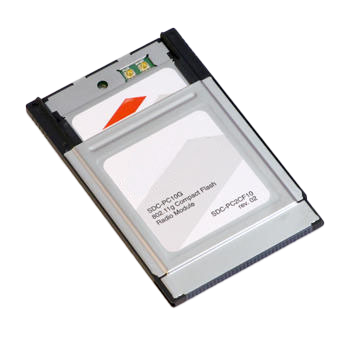PC10G

Overview
The SDC-PC10G provides all key Summit brand hardware and software capabilities in a PCMCIA (PC Card) form factor. The SDC-PC10G is ideal for integration into legacy application specific devices like portable data terminals, portable printers and medical devices. Hardware innovations enable the SDC-PC10G module to provide far greater performance and range than WLAN radio modules designed for office and consumer applications while minimizing power consumption and allowing for operation in challenging environments.
Note: This product has reached end of production and is available on a limited basis only.
Buy Now
Specifications
| Part Number | Price @ 1k | Antenna Type | Chipset (Wireless) | Compliance | Connector | Dimension (Height - mm) | Dimension (Length - mm) | Dimension (Width - mm) | Frequency Range (Max) | Frequency Range (Min) | Input Power | Logical Interfaces | Network Architecture | OS/Software | Operating Channels (2.4 GHz) | Operating Humidity | Operating Systems Supported | Power Consumption | Product Type | Protocols | Security | System Architecture | Technology | Weight | Wireless Specification |
|---|---|---|---|---|---|---|---|---|---|---|---|---|---|---|---|---|---|---|---|---|---|---|---|---|---|
| N/A | External | Broadcom BCM4318E | ETSI | PCMCIA Card | 5 mm | 85.6 mm | 54 mm | 2495 MHz | 2400 MHz | 3.3 VDC +/- 10% | PCMCIA | Infrastructure and ad hoc | Windows XP, Windows Embedded, Windows Mobile, Windows CE | ETSI:13 (3 non-overlapping). FCC:11 (3 non-overlapping). MIC:14 (4 non-overlapping) | 10 to 90% (non-condensing) | Windows Mobile | Transmit: 440 mA (1320 mW). Receive: 180 mA (594 mW). Standby: 10 mA (33 mW) | Embedded Module | Media Access: Carrier sense multiple access with collision avoidance (CSMA/CA) | Standards: Wireless Equivalent Privacy (WEP) | Hosted | 802.11abg | 1.058 oz (30 g) | 802.11 a/b/g Dual-Band N Wi-Fi |
Documentation
Software 34 total
Documentation 8 total
Name |
Part |
Last Updated |
|---|---|---|
| End of Life Announcement - PC10G.pdf | All | 01/17/2019 |
| Frequently Asked Questions - Wi-Fi Software Developers Kit.pdf | All | 01/17/2019 |
| Quick Start Guide - Wi-Fi on Windows CE and Mobile.pdf | All | 01/17/2019 |
| Quick Start Guide - Wi-Fi on Windows XP.pdf | All | 01/17/2019 |
| Software Integration Guide - For Windows Embedded.pdf | All | 01/17/2019 |
| Usage Notes - Laird Wi-Fi Software.pdf | All | 01/17/2019 |
| User Guide - Laird Regulatory Utility.pdf | All | 01/17/2019 |
| User Guide - Summit Software Developers Kit.pdf | All | 01/17/2019 |
Certification 14 total
Name |
Part |
Last Updated |
|---|---|---|
| EN 300 328 - CF10G.pdf | All | 01/17/2019 |
| EN 50371 - CF10G.pdf | All | 01/17/2019 |
| EU Standards Updates.pdf | All | 01/17/2019 |
| FCC 15B Test Report - CF10G.pdf | All | 01/17/2019 |
| FCC 15C Grant - CF10G.pdf | All | 01/17/2019 |
| FCC 15C Test Report (C2PC) - CF10G.pdf | All | 01/17/2019 |
| FCC 15C Test Report - CF10G.pdf | All | 01/17/2019 |
| FCC RF Exp Report - CF10G.pdf | All | 01/17/2019 |
| IC - Test Report - CF10G.pdf | All | 01/17/2019 |
| MIC - GZ Test Report - CF10G.pdf | All | 01/17/2019 |
| MIC - WW Test Report - CF10G.pdf | All | 01/17/2019 |
| MIC-GZ - CF10G.pdf | All | 01/17/2019 |
| MIC-WW - CF10G.pdf | All | 01/17/2019 |
| RoHS 3 Compliance - Wi-Fi Products | All | 03/06/2025 |
Become an Ezurio Customer to Gain Exclusive Access to Our Design Experts
- Antenna Scans
- Antenna selection and placement
- Custom antenna design
- Worldwide EMC testing / certifications
- Embedded RF hardware / firmware design
- Cloud architecture and integration
- Mobile application development
- Product & Industrial Design
Distributors
| Distributor | Phone Number | Region | Website |
|---|---|---|---|
| Arrow Electronics | 1-855-326-4757 +44 2039 365486 |
APAC, North America, South America, EMEA | Website |
| Braemac Australia, New Zealand, South East Asia | +61 2 9550 6600 +64 9 477 2148 |
APAC | Website |
| DigiKey | 1-800-344-4539 |
North America, South America, APAC, EMEA | Website |
| EBV Elektronik | EMEA | Website | |
| Farlink Technology China, Hong Kong | +86 13266922199 |
APAC | Website |
| Farnell | 1-800-936-198 +44 3447 11 11 22 |
EMEA | Website |
| Future Electronics | 1-800-675-1619 1-514-428-8470 |
North America, South America, APAC, EMEA | Website |
| Glyn | +49-6126-590-0 |
EMEA | Website |
| Hy-Line Germany Only | +49 89 614 503 0 |
EMEA | Website |
| Jetronic China, Hong Kong and Taiwan | 852-27636806 |
APAC | Website |
| M2M Germany | +49-6081-587386-0 |
EMEA | Website |
| Martinsson | +46 8 7440300 |
EMEA | Website |
| McCoy South East Asia | +65 6515 2988 |
APAC | Website |
| Mouser Electronics | 1-800-346-6873 +44 1494 427500 |
North America, South America, APAC, EMEA | Website |
| RS Components | +852-2421-9898 +44 3457-201201 |
North America, South America, APAC, EMEA | Website |
| Ryoyo Japan | +81-3-3543-7711 |
APAC | Website |
| Solsta UK Only | +44 (0) 1527 830800 |
EMEA | Website |
| Supreme Components International India, South East Asia | +65 6848-1178 |
APAC | Website |
| Symmetry Electronics | 1-866-506-8829 |
North America | Website |
| Tekdis Australia and New Zealand | +61 3 8669 1210 |
APAC | Website |
| Telsys | +972 3 7657666 |
EMEA | Website |
| WPG | +44 1628 958460 |
EMEA | Website |
 Laird Connectivity is now Ezurio
Laird Connectivity is now Ezurio/filters:background_color(white)/2024-12/SDC-PC10G.png)